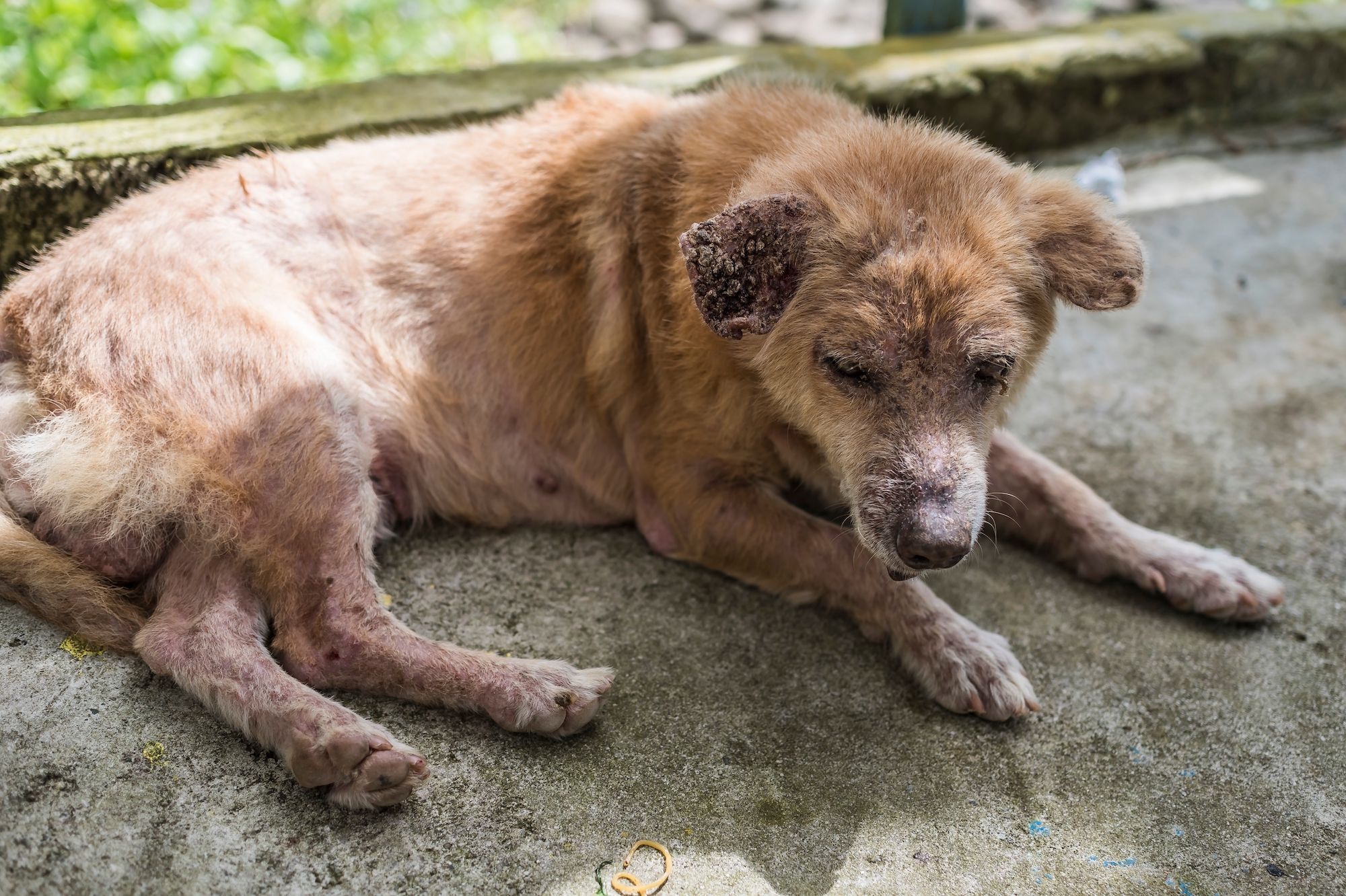You’ve probably heard of mange, or seen photos of dogs with the condition. It’s a skin disease caused by microscopic mites, that ranges from mild to more serious (and painful). It affects many kinds of animals, including dogs. If your dog is showing signs of mange, rest assured that the condition is treatable—but it’s critical to address it as soon as possible. Here’s what to look for, and what you can do about it.
What is mange, and how do dogs get it?
There are two types of mange in dogs: sarcoptic (also known as scabies), and demodectic (also known as demodex). Causes, prognoses, and treatments differ for each.
Sarcoptic mange is more common and highly contagious, passing easily from dog to dog. It can spread quickly if left untreated. Because foxes and coyotes can also carry the mites, dogs who live in areas with large populations of wild canids may become infected through direct contact.
This painful condition—often seen in stray or neglected dogs—can occur at any age, and is caused by Sarcoptes scabiei, an eight-legged, circular, parasitic mite. Dogs in high-stress environments, such as puppy mills and kennels, may be at higher risk too. Sarcoptic mange is zoonotic, meaning that infected dogs can transmit scabies to humans, who may experience a pimple-like rash or intense itching and should contact a doctor immediately. (People can find some relief through prescription medications, along with at-home treatments such as oatmeal baths, tea tree oil, or over-the-counter antihistamines.)
If you suspect that your dog has sarcoptic mange, and there are other pets at home, you should isolate your dog to prevent transmission—and take your dog to the vet right away. If other pets have been infected, all will require treatment to prevent further spread or reinfection.
Demodectic mange is caused by Demodex canis, an elongated, dagger-shaped mite. It differs from sarcoptic mange in that these mites are always present on the body, and are in fact a normal part of skin flora. (All dogs, and even many humans, have some of these mites on their skin at all times.) But “healthy” is the key word: in a well-functioning immune system, demodex is not harmful. Yet a system that fails to suppress demodectic mites allows them to over-multiply and become problematic.
In adult dogs, the occurrence of demodectic mange usually indicates a weakened immune system, which may be caused by illness, malnutrition, or medication—or it may simply be genetic. Elderly dogs with impaired immune systems, such as dogs with cancer or diabetes, are also susceptible. More often, however, demodectic mange shows up in “immature” immune systems, meaning a young dog typically 12 to 18 months old.
What are the signs of mange?
Sarcoptic mange results in intense itching—so much so that infected dogs may bite, chew, and scratch their skin incessantly. Apart from extreme itchiness, the most common symptoms include:
- Severe redness and rash
- Skin lesions
- Hair loss
- In extreme cases, emaciation, lethargy, or lymph node inflammation may occur
In demodectic mange, the itching may be less severe, but more visible: a dog will begin losing fur (or hair) in patches, typically starting on the face. The condition is considered localized when there are only a few patches. After it spreads to other areas, it is known as generalized, and is more serious, requiring more aggressive treatment. Signs of demodectic mange include:
- Red, bumpy, scaling skin and bald patches
- Redness all over the body, as well as swelling and crusts
- Extreme fur/hair loss
- Itching (not due to the mite itself but because of secondary bacterial infections
How is mange treated?
Take your dog to a vet for immediate attention, so you can learn the best way to treat your dog’s specific condition.
In instances of sarcoptic mange, you’ll want to help your suffering dog as soon as possible, of course, but it’s also important to prevent transmission to other pets (and humans) in your household. With demodectic mange, the urgency lies in getting your dog relief while the condition is still localized.
The vet will diagnose mange through clinical signs and diagnostic testing: the first step is usually a skin scraping to check for mites, mite eggs, and mite fecal material under a microscope. Then your dog will require treatment to control the mites and help skin heal.
Treatments include fur/hair clipping, weekly baths using medicated shampoo, and topical or oral applications to kill and eradicate the mites. To prevent reinfection, it’s essential to follow treatments for the recommended period of time.
For demodectic mange, some vets may also recommend nutritional supplements, as well as improving your dog’s diet to boost the immune system. A fresh-food diet may be a great option; the gentle cooking method used to make fresh food preserves vital nutrients that can help support dogs’ immune system. As with any serious health issue, though, be sure to get your vet’s guidance on the best steps to take.










